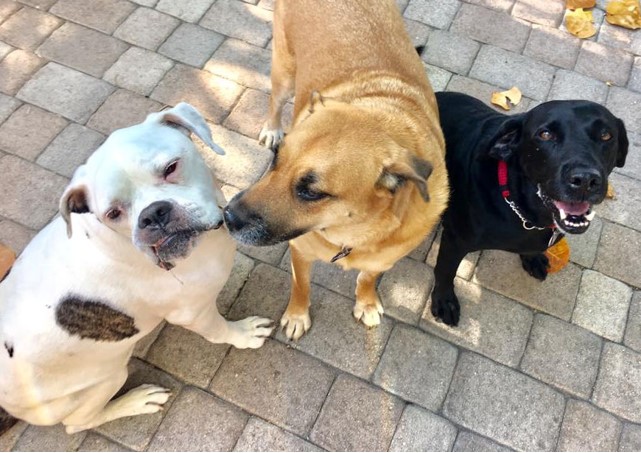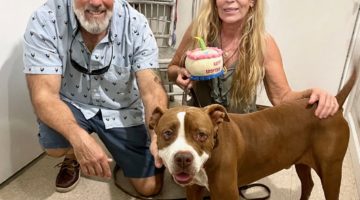RESCUE TAILS / BTA Big Dogs Foster Home
By Tara McFarland
Foster fail. We use the term “”foster fail”” when one of our foster families falls in love and adopts their foster pet. It’s an endearing term that describes the moment a foster family decides that the pet they opened their home and heart to, would be staying with them forever. Fostering is an incredibly valuable way to give back to our shelter, be it making room when we get full, caring for the sick or elderly, or helping a scared pet transition into a new home. Because our foster families often “”fail,”” we’re always in search of new foster homes. To help answer potential questions future foster families may have, we’’re interviewing our Marathon Campus’ own foster parent of BTA Big Dogs Foster Home, and foster fail, Julie.
Question: How long have you been a foster family?
Answer: We opened BTA Big Dogs Foster Home in 2014 on National Dog Day.
Question: What made you want to start fostering?
Answer: We started fostering shortly after our three rescue Labs and two cats had all passed away. We specifically wanted to start fostering medium and large dogs because shelters can be overcrowded easily with the larger breeds. The advantage we have is a large fenced- in yard that gives those larger dogs room to run, play, socialize and exercise. That, and I’m a sucker for dogs.
Question: How many dogs have you fostered?
Answer: Fifteen!
Question: What’s the most rewarding thing about fostering?
Answer: Placing a foster in a home that works as much for humans as it does for the dogs is obvious, but seeing the change in the dogs, as they become less fearful, more comfortable and better socialized. That dog may have come from a place where they were bounced around from the streets, to the shelter, to a foster home and that can be scary for a dog. Seeing a more confident and more comfortable dog is the most rewarding thing. Then I know we’ve done something right.
Question: What’s the most difficult thing about fostering?
Answer: The most difficult thing is how long it can sometimes take to place what we think is the absolute most perfect dog. We try to communicate to people what we see and know about these dogs that make them so special., tTrying to communicate that to people out there who may or may not be looking is difficult. We’ve had fosters here for as long as nine9 months. Gunner, one of our first, we kept as his retirement, sort of his old-age home. Making sure we communicate well and show the best part of that dog, that’s why I push with a lot of videos and pictures. People are looking across the thousands of adoptable dogs over the thousands of shelters, so we want to share what makes them unique. It can be frustrating if it takes a lot longer than you think it should.
Question: What’s your favorite foster memory?
Answer: SHACKALAKADINGDONG!! (Laughing) Shaka and Rambo, the lawless Lab twins (brothers) were the best memory because they were so playful. The fact that they got placed in two different families that they each fit in with perfectly and that the two couples were both in the military, and friends, and still keep in touch with each other, is amazing. Now Shaka lives in Hawaii!
Question: You’ve adopted one of your fosters. What made you decide to adopt, and now that you’ve adopted, how do you continue fostering?
Answer: We will always continue fostering because Princess (our foster fail) was a difficult foster because she had not been well socialized. Over the years, because she spent time with so many fosters, she went from a prior situation being sequestered in a separate room, to sharing space with over a dozen or more fosters in our home. She became well socialized and became the “”stabilizer.”” We’ve nicknamed her “the “General”” because she sets the tone of the territory, and the turf rules, which helps the fosters’ learning. Especially puppies. With our puppies she actually became a perfect mother figure teaching puppies proper dog skills. Our second adopted dog, Kona (from the Key West Campus), is our Zen dog and is a perfect dog for new foster dogs to meet and get acquainted with. He’s just an aloof kind of dog so it helps other fosters settle in. We have to foster, there’s always more!
Question: What advice would you give a first time foster family?
Answer: My advice is to tune out the people that say “”how can you foster, it would be so hard to give them up?”” Just ignore that. The first time you foster, yes, it’s natural to get attached or emotional and really start caring for the animal. But the day you place that animal with a new family that’s so excited to see their new dog that’s in a good place, that’s happy, that’s what’s going to keep you doing it again and again. I’ve never really had a hard time giving them up. Wendell was really hard, I never thought I would fall in love with a chihuahua. We’ve had all sorts of dogs, ages, breeds, but each one is a very different learning experience. Now we have a deaf foster and it’s a whole different set of learning skills for me. I have to learn to communicate with my eyes and my hands.
If you’re interested in becoming a foster family, the Florida Keys SPCA will provide everything you need such as supplies, food, medicine and Veterinary care. You provide an animal a safe and loving home until they’re ready to be adopted. Our foster coordinators will provide the education you need, and be readily available should problems or questions arise. Be sure to check out @BTABigDogsFoster on Facebook and contact [email protected] for more information on our foster program in Marathon or [email protected] in Key West.
[livemarket market_name="KONK Life LiveMarket" limit=3 category=“” show_signup=0 show_more=0]


No Comment